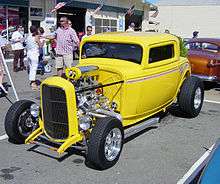Three window coupe

The three window coupé (commonly just "three-window") is a style of automobile characterized by two side windows and a backlight (rear window). Front windscreens don't count. The style was popular from the 1920s until the beginning of World War II. While many manufacturers produced three window coupés, the 1932 to 1936 Ford is a particular favorite of hot rodders. The three window coupé has a distinct difference from the five-window coupé, which has an additional window on each side.
Chopped top
One of the most popular modifications is a "chopped top". The trend began in the 1940s, and is not limited to three-windows by any means. It involves cutting the window pillars and removing a section to lower the roof height, to make the car look sleeker or 'racier'. The process may require new glass, relocation of door hinges, and raked (tilted back) A-pillars to meet the roof of the modified car structure.
Other modifications
Common modifications to include removing or changing fenders, hidden door hinges, removed ("shaved") door handles (to allow for solenoid-operated systems to unlatch the doors at the touch of a button), removed running boards, side-mounted exhaust systems ("Lake" pipes), exhaust diversions, or dual exhaust which incorporate one set of pipes under the car with mufflers to allow street approved performance and noise levels, and a cut-out in the main system for side pipes that have no mufflers and may incorporate "glasspacks" which is a tube filled with fibreglass that increases the volume and changes the pitch of the engine's roar.
See also
- Custom car
- Hot rod
- Ford Model B, the classic Deuce